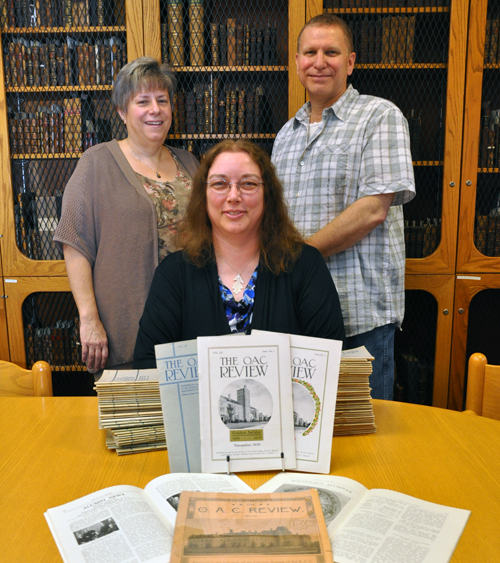
Long before Facebook, there was the OAC Review. A campus newspaper of sorts, the OAC Review covered everything from relationship statuses to grade point averages.
Published from 1889 to 1961, the OAC Review is now entering the digital age. The University of Guelph Library has begun digitizing issues dating back to 1939 – a formative year for the University on the cusp of the Second World War. The north part of campus was cordoned off by the Royal Canadian Air Force; Creelman Hall became a mess hall, Johnston Hall was used as a barracks, and military exercises took place on Johnston Green.
The library’s digital collections committee decided to digitize the OAC Review because the library had a complete collection in its archives, and some of the older issues are fragile. The publication also covered the history of the University’s three founders: Macdonald Institute, the Ontario Agricultural College and the Ontario Veterinary College.
“The digital collections committee at the library is coming at it from the preservation angle,” says Helen Salmon, information resources librarian, adding that many academic institutions are digitizing their archival collections. “The focus is usually on what’s unique and special to that organization, things that won’t be anywhere in the world but here.”

Digitization not only preserves the collection but also enhances its accessibility. Instead of spending hours in the library flipping through pages searching for the names of family members or friends, users can enter those names into a searchable PDF document from any computer and find matches within seconds. Referring to the OAC Review’s popularity among library users, Salmon says, “It gets asked for a lot, especially by alumni and their families.”
The digitization project began in May 2011 when Jennifer Oldham, a settlement studies and fine arts grad who returned to U of G to study psychology, joined the digitization team as an undergraduate research assistant. Cracking open the 1939 collection of issues, she noted that some of the most recognizable names in U of G history were just teenagers back then.
“It’s delightful to see Creelman as a 19-year-old,” says Oldham, adding that a former U of G president was known as Burt “Giggles” Matthews when he was a student. “It’s just a gold mine of what you can find,” she says. Some of the circulated copies contain “post-publication annotations,” such as hand-drawn moustaches on the photos.
Not only was the OAC Review a source of engagement and marriage notices, but there were also less rosy announcements about couples parting ways. Students’ grade point averages, including failed courses, were also published. More sombre content, such as death notices of alumni who had been killed in action during the Second World War, grew from one announcement per issue to filling entire columns.
The OAC Review was published eight times per academic year and contained about 70 pages of content written by alumni, students, faculty and staff. An annual subscription cost one dollar. The yellowed pages tell the history of not only the University but also the City of Guelph, Ontario and Canada.

Some of the most revealing insights can be found in the advertisements for everything from farm equipment to cigarettes. “The advertisements are just wonderful for the way they reflect the social mores of their time,” says Salmon, adding that the OAC Review is a treasure trove of agricultural, political and social history that would be of interest to a wide audience. “I think it could be a very interesting addition to some of the courses we do on local urban history.”
So far, more than 60 issues have been digitized from 1939 to 1947. The digitization process for one issue takes about eight hours, starting with scanning the original pages, editing the scanned images and performing a quality control check.
Currently, the online version of the OAC Review can be searched using “optical character recognition” of the text and images in the PDF documents that make up each issue. In the future, keyword searching will be available through the library’s Atrium web portal, making the OAC Review visible and searchable through Google and other internet search engines.
After viewing digital collections at other institutions, Oldham says she learned what not to do. “I would mutter to myself, ‘Why did the technician crop and fail to scan the last three columns of that census form?’ or ‘Couldn’t they have brought that into better focus?’ I was coming at it from that angle when I was digitizing. I wanted it to be a really clean and usable image because you can’t see the original; you’re relying on what the digitized image is telling you.” The paper copies will remain in the archives throughout the digitization process.
“It was very much a pilot project for us,” says Jim Brett, collections librarian. Their top priority was to make the information as accessible as possible. “The content that we created actually is, in some cases, better than archival because we keep it black-and-white so the contrast is there. We’ve tried to get the crispest image we can.”
The digitized copies have been uploaded to the Atrium, the University’s online research collection, and can be viewed at http://bit.ly/OACreview.